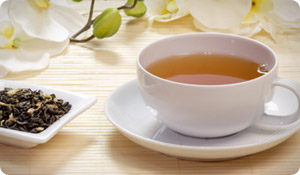
See what people are saying about this article on our Facebook page!![]()
Loose, bagged, home-brewed, or instant out of a bottle, tea is one of the most popular beverages in the world. And, depending on the form it takes, it can also be good for you. Or not.
There are two grades of tea-leaf and broken-and they are determined by sifting the leaves through screens with different sized openings. Leaf tea is used for loose tea preparation and broken leaf grades are used to make tea bags. Within each of these grades there are subgrades determined by the quality of the tea.
Whether your tea leaves are loose or bagged, the quality and flavor depends on many factors, such as variety, soil and weather conditions, land elevation, timing of growth, when the leaves are plucked and how they are handled during manufacturing. The highest quality tea leaves are associated with slow growth at a high elevation and early picking of younger leaves. Hand-plucked leaves are considered the finest quality because tea pickers are able to select only the youngest shoots from the tea plant.
Loose tea made from larger pieces of tea leaves usually produce a milder, lighter colored tea because the flavor and color are drawn out more slowly. Broken leaves usually produce a stronger, darker tea. The four basic types of tea all come from the same type of plant, but go through different forms of processing that create differences. For instance, black tea and oolong tea go through a fermentation process that darkens the leaf, while green tea and white tea leaves are steamed or pan-fried in order to destroy the enzymes in the leaves that encourage fermentation.
China has always been noted for its fine teas that grow slowly and are hardy at high altitudes. Black tea also comes from Argentina, Indonesia, Kenya and Sri Lanka. Green tea comes from Argentina, Germany, Japan and the Netherlands, as well as China. The tea you drink may be a blend of as many as 20 or more different types of leaves. The blending process accounts for the differences in flavor and strength among different brands of tea
Hot tea is popular in countries all over the world, but If you drink hot tea in the United States, you are in the minority. According to agricultural researchers at the University of Hawaii, about 80 percent of the tea consumed in this country is iced tea. Instant tea mixes are actually brewed teas that have been concentrated into powdered form and are usually mixed with flavorings, sweeteners and other additives.
The health benefits of tea comes from the antioxidant qualities of plant chemicals known as polyphenols, which are found in the leaves. Antioxidants prevent damage to body cells and repair already existing damage, and in that way help prevent the progression of disease. In general, loose-leaf, unfermented teas, such as loose green tea, are higher in antioxidants than bagged, fermented teas, such as the typical tea bags you buy in the supermarket. Bottled tea beverages have the least amount of antioxidants of all. In fact, a study presented at the 2010 national meeting of the American Chemical Society found that some bottled teas have practically no antioxidant activity at all, or so little that you would have to drink at least 20 bottles to get any benefits.
See what people are saying about this article on our Facebook page!![]()
Sources:
Tipton, TV et al.; "Tea." University of Hawaii, College of Tropical Agriculture and Human Resources, Department of Agricultural and Resource Economics; Aug 1990. Web 17 Feb 2011
http://www.ctahr.hawaii.edu/hnfas/publications/econFactSheets/tea.pdf
American Chemical Society. "Bottled Tea Beverages May Contain Fewer Polyphonols Than Brewed Tea." August 22, 2010. Web. 17 Feb 2011
http://portal.acs.org:80/portal/acs/corg/content?_nfpb=true&_pageLabel=PP_ARTICLEMAIN&node_id=222&content_id=CNBP_025388&use_sec=true&sec_url_var=region1&__uuid=aa9d1fbc-8a79-4132-9c63-8c3b575c93e3





